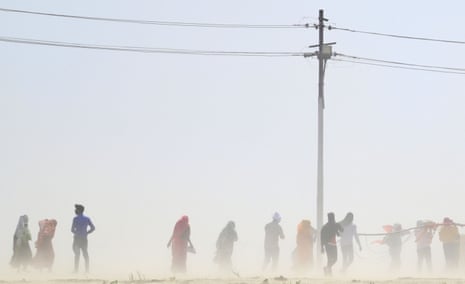As deadly heatwaves sweep through cities in India, China, the US and Europe amid the climate crisis, new research has found that rising temperatures are associated with a substantial rise in domestic violence against women.
A study published in JAMA Psychiatry on Wednesday found a 1C increase in average annual temperature was connected to a rise of more than 6.3% in incidents of physical and sexual domestic violence across three south Asian countries.
The study tracked 194,871 girls and women aged 15-49 from India, Pakistan and Nepal between 2010 and 2018, and their reported experiences of emotional, physical and sexual violence. It compared that data with temperature fluctuations across the same period. India, which already had the highest reported rates of intimate partner violence of the three, also had the biggest increase in abuse: with a 1C rise in heat came an 8% rise in physical violence, and 7.3% rise in sexual violence.
Countries around the world are already in the grip of extreme temperatures and heatwaves. This month, India was reporting temperatures up to 45C (113F) and dozens of heat-related deaths, Mediterranean Europe emerged from a record-breaking April heatwave, Texas entered its third week of deadly heat with temperatures up to 46C, and China urged people in northern cities to stay indoors as temperatures of over 40C broke records.
Michelle Bell, a professor of environmental health at Yale University and a co-author of the study, said that there were “many potential pathways, both physiological and sociological, through which higher temperature could affect risk of violence”. Extreme heat can lead to crop failures, buckle infrastructure, eat into economies, trap people indoors and render them unable to work – all factors that can place families under extreme stress and push up violence rates. The researchers found that although there was a heat-related increase in violence across all income groups, the largest increases were among lower-income and rural households.
The Indian activist Suniti Gargi, who used to work with Uttah Pradesh’s commission for women, said heatwaves were an annual occurrence during the Indian summer. She is convinced the climate crisis is making them worse and connects them with the rising levels of domestic violence she has been seeing.
“I’ve been seeing unusually high temperatures becoming more common,” she said. “They cause tremendous economic stress in families. If a man can migrate to another state to get work, it can help keep the home fires burning but when he cannot for whatever reason, his wife is at the receiving end of his anger and feelings of uselessness.”
One woman, speaking through Gargi, said when the May and June heat hit and it became impossible for her husband to work in the fields, they would lose their only source of income. “He becomes angry because he feels helpless about not being able to feed the children,” she said. “When the frustration builds up and the children are whining and fighting, he takes it out on me. He also beats them too. He regrets hitting the children later but the next day when he still can’t go out and earn, he does it again.”
The study by Fudan University, Shanghai, adds to a growing body of research showing how rising temperatures can fuel a more violent world, particularly for women. Previous research from Madrid found that when a heatwave hit, the risk of intimate partner femicide rose 40%, and in Kenya, women who experienced severe weather events – including heatwaves – had 60% higher odds of reporting intimate partner violence. Studies collating global data have found the risks of interpersonal violence increased by 2.3% and intergroup conflicts by 13.2% as temperatures rose.
As well as social and economic factors, the heat can go to work on the human body. “There is growing evidence that extreme heat can affect stress, lower inhibitions, increase aggression, and exacerbate mental illness,” Bell said. Past research has found that acute heat exposure is associated with increased adrenaline production, which could activate higher aggression, and activate the brain areas associated with emotion regulation. Heatwaves are also associated with worsening the effects of mental illness, including anxiety and post-traumatic stress disorder.
While many countries already count deaths from heat-related illness during heatwaves, they would not capture the hidden toll of a heat-related rise in women killed in domestic violence incidents. Many of the adverse health outcomes of climate change “are well studied – such as mortality from heatwaves”, Bell said. “The true public health impact of climate change is likely underestimated due to many other less well-studied health risks, such as that described in this study.”
after newsletter promotion
In the north-east of India’s Bihar state, near the border with Nepal, Shilpi Singh, who is the director of Bhoomika Vihar, which has been helping the victims of domestic violence for 15 years, said the climate crisis had worsened the traditionally unequal relations between men and women.
She said: “Beating up your wife in the countryside is routine, even in good times. A man sees it as his right, as part of his authority over his wife, to beat her when he wishes.
“The women have internalised this and accept it as his right. What is new is that frustration because of extreme heat or erratic weather … It creates economic hardship for the family and that makes even the traditional situation where wife-beating is the norm, even worse.
“The women tell me that when there is no heatwave or flooding and the man goes out to work, the situation is easier. He is out for most of the day. But when extreme weather makes him idle and forces him to stay at home, the anger and tension over not being able to provide – and the sheer hunger in the family – creates anger in him.”
